Ijraset Journal For Research in Applied Science and Engineering Technology
- Home / Ijraset
- On This Page
- Abstract
- Introduction
- Conclusion
- References
- Copyright
Empowering Collectors with Real-Time Weather Insights for Optimal Collection Conditions
Authors: Dr. Ramya R, Shree Haree M, Arvind S, Roshan S
DOI Link: https://doi.org/10.22214/ijraset.2024.61446
Certificate: View Certificate
Abstract
A cutting-edge Air QualitCy Monitoring System leveraging Node MU was developed to tackle the mounting concerns surrounding air pollution. The system comprehensively monitored various parameters including Suspended Particulate Matter (SPM), Carbon Dioxide, Ozone, Carbon Monoxide, Smoke, temperature, and humidity. To capture pollutant data, sensors such as MQ4, MQ135, MQ9, and DHT11 were employed. These sensors gathered data, which were then processed using an Analog to Digital converter and analyzed utilizing the software capabilities of Node MCU. The experiment was conducted in Rajarhat, New Town, Kolkata, and the obtained results were compared against data from the local environmental control authority. The comparison highlighted the system\'s effectiveness in providing real-time data for informed decision-making amidst the heightened air pollution prevalent across Indian cities.
Introduction
I. INTRODUCTION
The Internet of Things (IoT) marks a transformative shift in our interaction with the world, comprising interconnected devices, sensors, and actuators exchanging data seamlessly over the internet. Ranging from household appliances to industrial machinery, these devices play a pivotal role in various domains.
The rapid industrialization, urbanization, and population growth of recent decades have significantly escalated global air pollution levels, posing severe threats to human health, ecosystems, and economies. This urgency has sparked calls for action to address this environmental menace. Central to effective air quality management is the availability of reliable data on air pollutant concentrations, crucial for policymaking, pollution control, and public awareness efforts.
However, traditional air quality monitoring methods face challenges such as limited spatial coverage, delayed data reporting, and high infrastructure costs. Addressing these limitations necessitates innovative solutions capable of providing real-time, high-resolution data across diverse geographical areas. This paper presents a novel integrated air quality monitoring system designed to meet these demands effectively.
II. LITERATURE REVIEW
Yuxuan Cao, Difei Zhang, Shaoqi Ding, Weiyi Zhong, and Chao Yan presented a Hybrid Air Quality Prediction Model in their study titled "A Hybrid Air Quality Prediction Model Based on Empirical Mode Decomposition" published in Tsinghua Science and Technology. [1] The model aims to forecast air quality indicators from multiple monitoring stations in the upcoming hours by combining the extended ARIMA model with the EMD method and truncated SVD for enhanced prediction accuracy. EMD is utilized to break down the original nonstationary air quality indicator series into smoother sub series. February 2024.
Shorouq Al-Eidi, Fathi Amsaad, Omar Darwish, Yahya Tashtoush, Ali Alqahtani, and Niveshitha “Comparative Analysis Study for Air Quality Prediction in Smart Cities Using Regression Techniques”, [2] delves into a thorough comparison of various regression models to forecast air quality in smart cities. Emphasizing the benefits of integrating cloud computing in regression analysis, the study highlights how the use of cloud resources minimizes model processing time, consequently improving overall efficiency and scalability. October 2023.
Martha Arbayani Zaidan, Naser Hossein Motlagh, Pak Lun Fung, Abedalaziz S. Yutaka Matsumi, Aijun Ding, Sasu Tarkoma, Tuukka Petäjä, Markku Kulmala, and Tareq Hussein explored the topic of calibrating intelligent air pollution sensors to monitor extreme events and drifts in their paper titled "Intelligent Air Pollution Sensors Calibration for Extreme Events and Drifts Monitoring" published in the IEEE Transactions on Industrial Informatics.
[3] They introduced a method for sensor calibration that corrects LCS readings and detects calibrators' drift through controlled experiments conducted in an indoor setting to define scenarios for extreme events. February 2023.
Tarun Kumara and Amulya Doss presented a paper titled "AIRO: Development of an Intelligent IoT-based Air Quality Monitoring Solution for Urban Areas" at the International Conference on Machine Learning and Data Engineering.[4] The worsening air quality in Bengaluru emphasizes the necessity for a distributed air quality monitoring system to gain insights into pollutant levels across different city zones. Through the continuous observation and control of real-time pollutant levels, it is possible to prevent respiratory ailments caused by air pollution. AIRO emerges as an IoT-centered decentralized solution for monitoring air quality, offering instantaneous Air Quality Index (AQI) readings. 2023.
Martha Arbayani Zaidan, Yuning Xie, Naser Hossein Motlagh, Bo Wang, Wei Nie, Petteri Nurmi, Sasu Tarkoma, Tuukka Petäjä, Aijun Ding, and Markku Kulmala's research on 'Dense Air Quality Sensor Networks: Validation, Analysis, and Benefits' published in the IEEE Sensors Journal proposes a system for detecting and monitoring air quality.[5] This system utilizes wireless sensor networks to monitor air quality in various locations, providing real-time data that can be accessed via smart devices and the web. This innovation enables individuals, especially those with underlying health conditions, to monitor the air they breathe effectively. December 2022
Achal R Dhote, Rashami G Raut, Sham S Raut, Rakshanda P Hedaoo, Dr. Vrushali G Nasre published a study titled 'Air Quality Monitoring System Based On IOT' in the International Research Journal of Modernization in Engineering Technology and Science.[6] This study focuses on the utilization of a DHT11 sensor in conjunction with an I2C module connected to an LCD display for monitoring air quality. The importance of monitoring air quality lies in raising awareness among individuals to protect the well-being of future generations for a healthier life. March 2022.
Wen Tsai Sung, Sung Jung Hsiao focused on “Building an indoor air quality monitoring system based on the architecture of the Internet of Things” EURASIP Journal on Wireless Communications and Networking, [7] Their research aimed to enhance overall living standards by ensuring good indoor air quality. By achieving this goal, they aimed to reduce the likelihood of children and individuals with allergies suffering from asthma and respiratory issues caused by poor air quality. Additionally, the study aimed to prevent decreased office productivity and sleepiness induced by high CO2 levels. Ultimately, the researchers strived to establish high-quality indoor air environments for the general public. 2021.
Meghana P Gowda, Harshitha G Y, Jyothi K N, Srushti, Padma R, authored a study on the "Air Quality Monitoring System" published in the International Journal of Engineering Research & Technology (IJERT).[8] The system employs the MQ135 Gas Sensor to detect pollutants like benzene, alcohol, and smoke in the environment. An Arduino microcontroller is utilized in conjunction with IOT Technology to enhance air quality monitoring. It includes a Wi-Fi module for internet connectivity and easy access to air quality information. Moreover, users can track pollution levels on their mobile devices through a dedicated application. 2021.
T. Dineshkumar, V. Suresh Babu, Pachaivannan Partheeban, and R. Puviarasi, "Air Quality Monitoring System Based on IoT" ICACSE Journal of Physics: Conference Series,[9]. The aim of this project was to create an air quality monitoring system utilizing Internet of Things technology for the evaluation of local air quality. By employing sensors, this device can track the levels of various substances in the air, including O3, SO2, CO, and particulate matter.
Debo-Saiye Yomi and Ajose-Ismail Babatunde M., presented a study titled "IOT Based Air Quality Detection and Monitoring System", in the International Journal of Research and Innovation in Applied Science (IJRIAS). [10] To oversee air quality in different areas, the recommended system utilizes a wireless sensor network. It provides data and updates almost instantly, accessible through web-enabled devices and smartphones. Consequently, this study enables individuals, especially those with preexisting medical conditions, to keep track of the air they are breathing. December 2020.
Radhika M. Patil, Dr. H. T. Dinde, and Sonali K. Powar conducted “A literature review on the prediction of air quality levels and the forecasting of ambient air pollutants through machine learning algorithms”, published in the International Journal of Innovative Science and Research Technology. [11]. Their study is focused on providing a detailed comprehension of the Air Quality Index (AQI), which serves as an indicator of air contamination in the surrounding environment. Understanding the AQI is essential as it informs individuals about the adverse effects and potential risks associated with air pollution, prompting them to take necessary steps to address this issue. August 2020.
Dr. M. Krishnamoorthi, M. Arunkumar, R. G. Chandini, T. Deepika, J. Mohamed Yazar conducted a study titled "IOT based Air Quality Monitoring System" published in the International Journal for Research in Applied Science & Engineering Technology (IJRASET). [12].
Their research focuses on utilizing advanced hardware and innovative concepts to monitor the environment effectively, control pollution, and enhance our comprehension of it. The significance of this study lies in its utilization of predictive algorithms to not only measure air quality but also offer insights into the environmental conditions. July 2020.
P. Prasanna Ganapathy, B. Prakash Raj, M. Nandha, A. Naveen Kumar, and Dr. S. Sekar presented a study on the "IoT based Air Quality Monitoring System" in the International Research Journal of Engineering and Technology (IRJET). [13] Corrections were made to the PPM counts mentioned in the Literature Review as part of this research. This system is versatile and can be utilized both outdoors and indoors. Implementing this monitoring kit in households could enable the tracking of indoor air quality in specific targeted regions, facilitated by its compact design. However, for outdoor applications, the use of multiple sensors is essential, as the sensitivity range of a single sensor is limited to approximately one meter. March 2020.
Ashwini M. S., P. Ganesh, and Dwarakanath G. V in their study "Air Pollution Monitoring System using NodeMCU and Air Quality Sensors", published in the International Journal of Innovative Technology and Exploring Engineering (IJITEE). [14] The study elaborates on enhancing the automation process by incorporating modern technologies such as gas and air quality sensors along with Node microcontroller unit boards. This setup ensures that the cloud receives real-time data identical to what the mobile app displays regarding the air quality status. Furthermore, by analysing the stored cloud data, one can assess the air quality specific to a given area. July 2019.
Rawal Ramik, “Air Quality Monitoring System”, International Journal of Computational Science and Engineering. [15] The study explores the development of an Previous research utilized Bluetooth, GPS, and GPRS technologies in conjunction with various sensors to monitor indoor and outdoor air quality. Instead of the costly WASP module, alternative sensors can fulfill the same purpose. The proposed solution is tailored for remote monitoring of indoor air quality, incorporating both address- and data-centric protocols in an efficient request-and-respond format. This paper presents an overview of the diverse methods employed in air quality monitoring. 2019.
F.N. Setiawan and I. Kustiawan, "IOT based Air Quality Monitoring" in their paper presented at the International Symposium on Materials and Electrical Engineering (ISMEE) [16]. With the current ease of detecting air pollution, the necessity of an air quality sensor becomes apparent. A device known as an air quality detector is crucial for humans to easily identify the presence of air pollution. 2017.
III. METHODOLOGY
The methodology employed in the development of the integrated air quality monitoring system is a multi-faceted approach that encompasses various stages, each crucial for ensuring the system's accuracy, reliability, and usability. The process begins with meticulous sensor selection, where commercially available sensors are rigorously evaluated based on their suitability for measuring target air pollutants, response time, sensitivity, and environmental robustness. Sensors exhibiting optimal performance characteristics are then subjected to extensive calibration procedures to mitigate inherent biases, drift, and cross-sensitivity effects. Calibration curves are established through controlled laboratory experiments, correlating sensor readings with reference measurements obtained from certified instruments. These calibration curves serve as the basis for converting raw sensor outputs into accurate and reliable air pollutant concentrations. Following sensor calibration, the next stage of the methodology involves the design and implementation of data acquisition and transmission modules. These modules are responsible for collecting sensor readings at regular intervals and transmitting them to a centralized data repository for further analysis. Wireless communication protocols, such as MQTT, LoRaWAN, or Zigbee, are utilized to establish robust communication links between the sensor nodes and the central data hub. Data encryption and authentication mechanisms may be employed to ensure data security and integrity during transmission. The data acquisition modules are designed to be energy-efficient and scalable, capable of supporting large-scale deployments across diverse geographical areas. Once the sensor data are collected and transmitted to the central data repository, the subsequent step in the methodology involves data processing and analysis. Custom algorithms are developed to process the raw sensor data, perform quality checks, and generate actionable insights into air quality metrics, such as pollutant concentrations, air quality indices, and exposure levels. Machine learning techniques, including regression models, clustering algorithms, and anomaly detection methods, may be employed to enhance data quality, identify trends, and detect abnormal patterns in the sensor data. The processed data are visualized using various techniques, including charts, graphs, maps, and dashboards, to facilitate easy interpretation and decision-making by stakeholders. Continuous monitoring and iterative refinement of the data processing algorithms are conducted to ensure the reliability and accuracy of the air quality metrics generated by the integrated system.
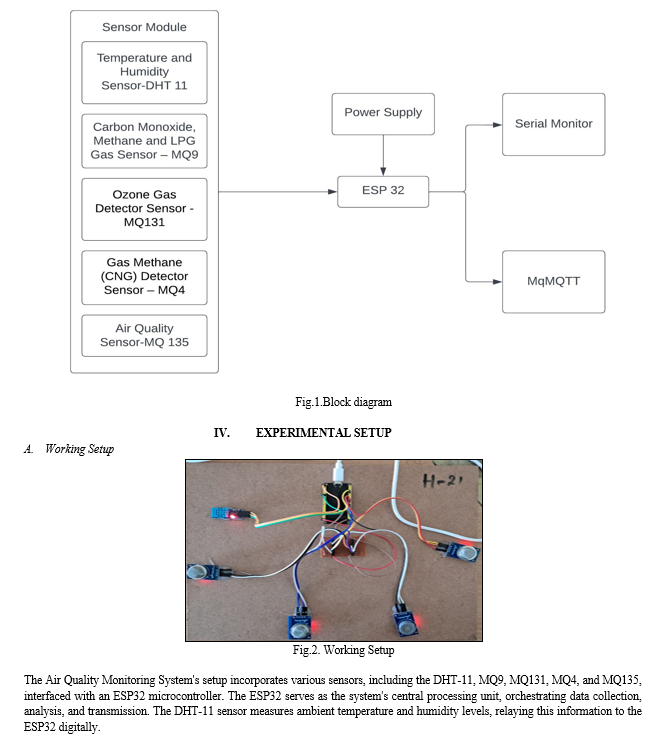
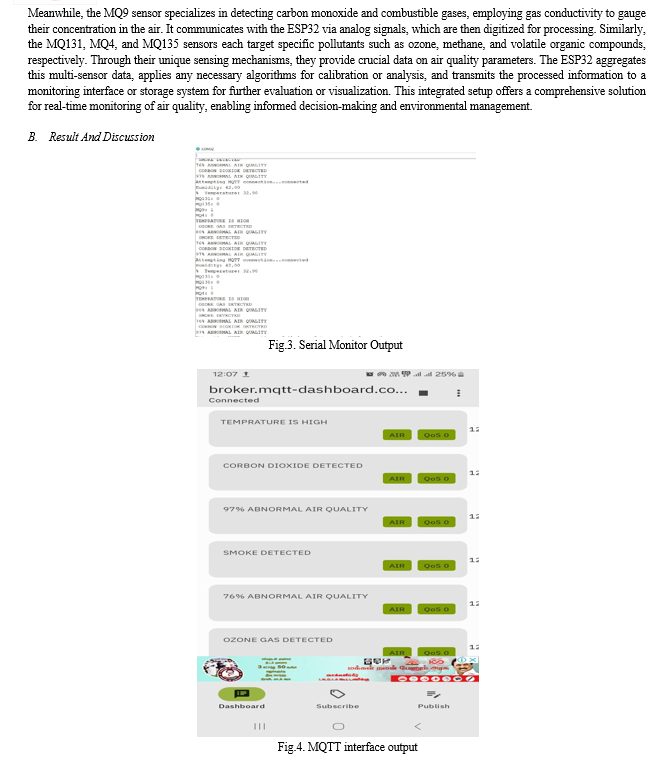
- Publish/Subscribe:
The foundation of the MQTT protocol is the idea of "pub/sub," or posting messages and subscribing to topics. A broker connects to several clients, each of whom subscribes to a topic of interest. Moreover, clients communicate with the broker and post messages on themes. Numerous customers might subscribe to the same topics and use the data anyway they see fit. Everything connects to a single, straightforward interface provided by the broker and MQTT.
2. Topics/Subscriptions:
MQTT allows messages to be published on topics. Setting up a topic is not necessary; just publishing content on it will do. A slash (/) is used as a separator between topics in a hierarchy. Similar to a filesystem, this enables the logical ordering of common themes to be constructed. For instance, several machines might each post their hard drive temperature data on the following page, replacing the names of the individual computers and hard drives as necessary:
3. Client:
When we refer to a client in the context of messaging protocols, especially MQTT, it typically implies an MQTT client. MQTT clients can take on various roles, such as subscribers or publishers, indicating whether they are currently sending or receiving messages. It's worth noting that a single MQTT client can perform both publishing and subscribing tasks simultaneously.
An MQTT client can be any device equipped with a MQTT library that connects to an MQTT broker over a network. This includes a wide range of devices, from microcontrollers with limited resources to full-fledged servers. For instance, a small, wirelessly network-connected device with minimal resources and a lightweight MQTT library can function as an MQTT client. Similarly, a standard PC running a graphical MQTT client software can act as a client for testing purposes.
The MQTT protocol is designed to be straightforward and user-friendly on the client side, making it easy to use for various applications. Its simplicity and ease of installation make it particularly suitable for small devices with limited resources.
MQTT client libraries are available in numerous programming languages, catering to a wide range of developers. These languages include Android, Arduino, C, C++, C#, Go, iOS, Java, JavaScript, and .NET, among others. The MQTT wiki provides an extensive list of supported languages and libraries for MQTT clients.
4. Broker:
The MQTT broker acts as the counterpart to the MQTT client and serves as a central component in any publish/subscribe protocol. It has the crucial responsibility of managing numerous concurrently connected MQTT clients, depending on its implementation capabilities. All communication flows through the broker, which filters messages, determines client subscriptions, and delivers messages accordingly. The broker also maintains sessions for persistent clients, including their subscriptions and any missed messages.
Furthermore, the broker verifies and authorizes clients, often supporting customizable authentication and authorization mechanisms. Given its pivotal role in managing a large number of clients and facilitating message transfer, seamless integration with backend systems is essential. Monitoring, scalability, resilience, and integration into backend systems are vital aspects to consider when selecting a broker.
HiveMQ, for instance, utilizes an open plugin system, standard monitoring providers, and state-of-the-art event-driven network processing to ensure monitorability, scalability, resilience, and seamless integration with backend systems, meeting the stringent criteria required for an efficient MQTT broker.
5. MQTT Connection
The MQTT protocol is built upon the TCP/IP protocol stack. Both the MQTT broker and clients rely on TCP/IP for communication. It is essential for both the broker and the client to have a functioning TCP/IP stack to establish and maintain connections, ensuring reliable data transmission over the network.
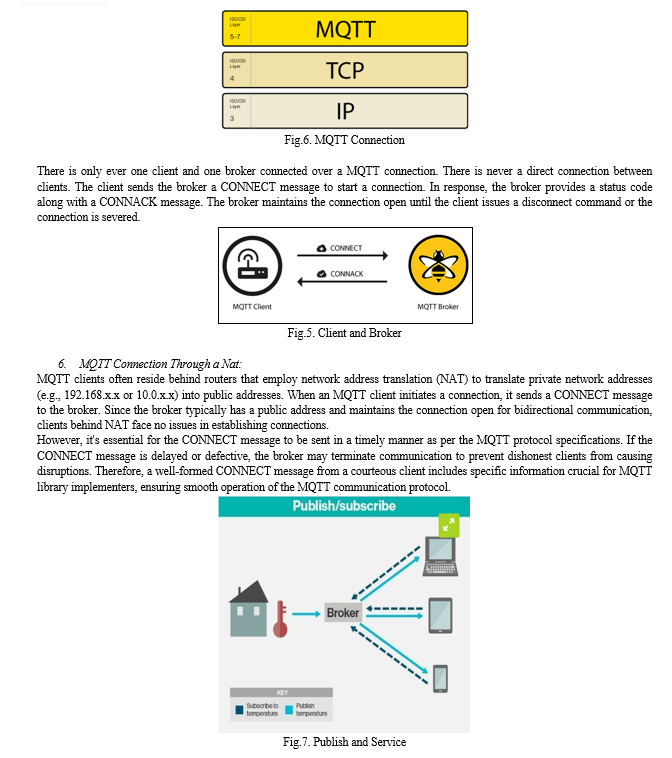
7. CLIENTID:
The Client Identifier (ClientId) plays a crucial role in MQTT, as it uniquely identifies each MQTT client connecting to a broker. This identifier allows the broker to recognize the client and maintain its current state. It's essential for the ClientId to be unique per client and broker to avoid conflicts.
In MQTT 3.1.1, the current standard, it's permissible to send an empty ClientId if there's no need for the broker to maintain any state for the client. In such cases, the connection will be established without any associated state. However, it's imperative that the clean session flag be set to true, indicating to the broker that no prior session state should be retained. Failure to set this flag appropriately will result in the broker rejecting the connection.
8. Clean Session
The broker is informed by the clean session flag whether or not the customer wishes to create a persistent session. When a client subscribes with a Quality of Service (QoS) level 1 or 2, the broker retains all of the client's subscriptions as well as all of the client's missed messages in a persistent session (CleanSession = false). The broker deletes all data from any prior persistent session and does not keep anything for the client if the session is not persistent (CleanSession = true).
9. Username/Password
For client authentication and permission, MQTT has the ability to transmit a user name and password. Nonetheless, the password is sent in clear text if this data isn't hashed or encrypted (via TLS or implementation). We strongly advise using a secure transport in conjunction with user names and passwords. There is no need for a username and password because brokers such as HiveMQ can authenticate clients using an SSL certificate.
10. Will Message
The Last Will and Testament (LWT) feature of MQTT includes the last will message, which serves to inform other clients when a client disconnects abruptly. When a client establishes a connection, it can specify a last will message along with a topic to the broker within the CONNECT message. In the event of an ungraceful disconnection by the client, the broker dispatches the LWT message to notify other clients on behalf of the disconnected client.
11. History Of The MQTT Protocol
In 1999, Dr. Andy Stanford-Clark of IBM and Arlen Nipper of Arcom, later Eurotech, collaborated to develop MQTT. Originally conceived to establish reliable and cost-effective connections between remote corporate computers and monitoring equipment in the oil and gas industries, MQTT aimed to tackle the challenge of reducing satellite link transmission costs. They devised an event-driven, TCP/IP-based publish/subscribe topology to transmit data from sensors in remote pipeline locations to off-site supervisory control and data acquisition (SCADA) systems. While MQTT was not initially part of IBM MQSeries, it gained support over time, with version 7.1 of WebSphere MQ incorporating it. Despite its name suggesting otherwise, MQTT was not included in the original IBM MQSeries. Eventually, MQTT evolved into an open protocol governed by the Organization for the Advancement of Structured Information Standards (OASIS), while still maintaining close ties with IBM. Before standardization, MQTT was known by various names including the SCADA protocol, MQ Integrator SCADA Device Protocol (MQIsdp), and WebSphere MQTT (WMQTT).
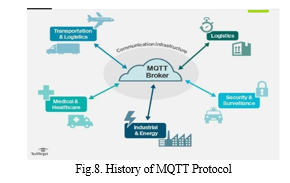
Facebook utilizes MQTT for its Messenger app due to its ability to conserve battery life during mobile phone-to-phone messaging. Additionally, MQTT enables the rapid transmission of messages, often in milliseconds, even in the face of unreliable internet connections worldwide.
Major cloud service providers like Google Cloud, IBM Cloud, Microsoft Azure, and Amazon Web Services (AWS) support MQTT, further enhancing its adoption and interoperability across diverse platforms and ecosystems.
Applications leveraging machine-to-machine (M2M) and IoT devices for real-time analytics, preventative maintenance, and environment monitoring derive significant benefits from MQTT. These applications span various sectors including smart homes, healthcare, logistics, industry, and manufacturing, underscoring MQTT's versatility and effectiveness in diverse use cases.
12. MQTT IN IOT
MQTT stands out as one of the most commonly utilized protocols in the realm of IoT. It facilitates communication between IoT devices, even those with limited resources, by enabling them to publish information on specific topics to a central server acting as an MQTT message broker. The broker then disseminates this information to clients that have subscribed to relevant topics. These topics are structured hierarchically, resembling file paths, making it intuitive for users to navigate. Clients have the flexibility to subscribe to multiple levels of the topic hierarchy using wildcard characters or opt to subscribe to only a single level, depending on their requirements.
13. Competing Protocols
Several alternative transfer protocols compete with MQTT in the realm of IoT communication:
a. Constrained Application Protocol (CoAP): CoAP utilizes a request/response communication pattern and is well-suited for IoT applications.
b. Advanced Message Queuing Protocol (AMQP): Like MQTT, AMQP employs a publish/subscribe communication pattern, offering an alternative approach for IoT communication.
c. Simple/Streaming Text Oriented Messaging Protocol (STOMP): STOMP is a text-based protocol that utilizes a send semantic with destination strings. It differs from MQTT by not incorporating queues and topics.
d. Mosquitto: Mosquitto is an open-source MQTT broker, providing a platform for MQTT-based communication within IoT ecosystems.
e. Simple Media Control Protocol (SMCP): SMCP, built on the CoAP stack, finds utility in embedded contexts and is primarily C-based, catering to resource-constrained environments.
f. Simple Sensor Interface (SSI): SSI serves as a communication protocol facilitating data transfer between computers and sensors, offering a solution for integrating sensor data into broader IoT systems.
g. Data Distribution Service (DDS): DDS stands out as a middleware standard designed for real-time systems. It enables embedded devices to publish or listen to communications directly, ensuring real-time data exchange in IoT environments.
14. Pros And Cons Of MQTT
MQTT stands out among competing protocols due to several key advantages:
a. Lightweight Protocol: MQTT's lightweight nature enables efficient data transmission and swift implementation, making it ideal for resource-constrained IoT environments.
b. Low Network Usage: By minimizing data packets, MQTT reduces network usage, optimizing bandwidth utilization and lowering operational costs.
c. Efficient Data Distribution: MQTT excels in distributing data efficiently across networks, facilitating seamless communication between devices and systems.
d. Remote Sensing and Control: MQTT enables successful implementation of remote sensing and control applications, allowing users to monitor and manage devices from distant locations.
e. Fast Message Delivery: MQTT ensures fast and efficient message delivery, crucial for real-time applications where timely information dissemination is essential.
f. Low Power Consumption: MQTT's minimal power requirements are advantageous for connected devices, prolonging battery life and enhancing overall energy efficiency.
g. Bandwidth Reduction: By efficiently managing data transmission, MQTT contributes to reducing network bandwidth usage, improving overall network performance and scalability.
15. Potential Downsides To MQTT Include The Following
In comparison to CoAP, MQTT presents several distinct characteristics and challenges:
a. Slower Transmit Cycles: MQTT tends to have slower transmit cycles when compared to CoAP, impacting the speed of data transmission between devices.
b. Resource Discovery Mechanisms: MQTT's resource discovery relies on flexible topic subscription, allowing for dynamic exploration of resources. In contrast, CoAP employs a stable resource discovery system, which may offer more predictable and structured resource identification.
c. Encryption and Security: MQTT lacks built-in encryption and security features. Instead, it relies on external protocols like TLS/SSL for securing data transmission, potentially adding complexity to implementation and management.
d. Scalability Challenges: Establishing a globally scalable MQTT network can be challenging due to various factors such as managing large volumes of connected devices, ensuring reliable communication across diverse geographical locations, and coordinating network infrastructure for seamless operation on a global scale.
16. MQTT Challenges: Security, Interoperability And Authentication
Historically, the MQTT protocol has found use in secure back-end networks for specific applications, with security not being a primary focus during its initial development. The MQTT topic structure can quickly grow into complex trees, posing challenges for breaking them into manageable federation-ready logical domains. This complexity hampers the construction of globally scalable MQTT networks as the topic tree expands.
Another drawback of MQTT is its lack of compatibility. Issues may arise when message payloads are binary and lack encoding information, particularly problematic in open architectures where seamless interoperability among programs from different manufacturers is crucial.
Moreover, MQTT offers limited built-in authentication options. Usernames and passwords are transmitted in cleartext, necessitating the use of SSL/TLS for secure MQTT usage, which unfortunately adds overhead. Client-side certificate authentication is intricate, and MQTT lacks mechanisms for controlling topic ownership and information publication, except through out-of-band, proprietary methods, leaving networks vulnerable to malicious communications.
Additionally, without information contained within the message itself, recipients cannot identify the message's sender, complicating security implementations. Proprietary security layers atop MQTT increase code complexity, undermining its lightweight nature and making implementations more challenging.
17. Quality of Service Levels:
Quality of Service (QoS) in MQTT refers to the agreement between the message sender and its recipient, specifying the level of guarantee for message delivery. This feature allows MQTT clients to select from three levels of service, each offering varying degrees of assurance regarding message delivery.
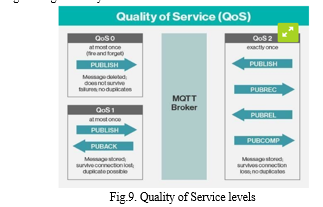
The MQTT protocol offers three distinct Quality of Service (QoS) levels, each dictating how the protocol manages message content. While higher QoS levels provide greater reliability, they also incur increased latency and bandwidth requirements. Subscribing clients have the flexibility to specify the highest QoS level they desire to receive, allowing them to balance between reliability and resource consumption according to their specific needs.
C. Efficiency Of The Proposed System
The efficiency of the proposed Air Quality Monitoring System lies in its ability to provide accurate, real-time data on various air pollutants while offering several advantages over existing solutions. Firstly, the integration of multiple sensors, including the DHT-11, MQ9, MQ131, MQ4, and MQ135, allows for comprehensive monitoring of key air quality parameters such as temperature, humidity, carbon monoxide, ozone, methane, and volatile organic compounds. This multi-sensor approach enhances the system's capability to detect a wide range of pollutants, thereby providing a more holistic view of air quality conditions.
D. Comparison Of Existing And Proposed System
When comparing the existing air quality monitoring system to the proposed one, several notable distinctions emerge, underscoring the advantages and improvements of the latter. Firstly, the proposed system boasts real-time data updates, a feature often lacking in traditional systems where data can be delayed, providing users with outdated information. This real-time capability enhances the system's responsiveness and utility for making timely decisions related to air quality management. Additionally, the proposed system demonstrates cost-effectiveness, leveraging readily available components like the ESP32 microcontroller and MQ-series gas sensors, which significantly reduces both setup and maintenance costs compared to proprietary solutions. Moreover, its user-friendly interface makes air quality information more accessible and comprehensible to a wider audience, fostering greater engagement and awareness among researchers, policymakers, and the general public.
Conclusion
An IoT-based real-time weather monitoring system collects data from various sensors to provide up-to-the-minute weather information. Using connected devices, it measures temperature, humidity, air quality and other parameters. The data is transmitted to a central server for analysis and made accessible through a user-friendly interface. This system enables timely and accurate weather updates, aiding in better decision-making for various applications, from agriculture to disaster preparedness. Its integration with IOT technology ensures seamless connectivity and efficient data transmission, making it a valuable tool for monitoring and responding to changing weather conditions.
References
[1] Yuxuan Cao, Difei Zhang, Shaoqi Ding, Weiyi Zhong, and Chao Yan “A Hybrid Air Quality Prediction Model Based on Empirical Mode Decomposition” Tsinghua Science And Technology, Volume 29, Number 1, February 2024. [2] Shorouq Al-Eidi, Fathi Amsaad, Omar Darwish, Yahya Tashtoush, Ali Alqahtani and Niveshitha “Comparative Analysis Study for Air Quality Prediction in Smart Cities Using Regression Techniques”, IEEE Access, October 2023. [3] Martha Arbayani Zaidan, Naser Hossein Motlagh , Pak Lun Fung, Abedalaziz S. Khalaf , Yutaka Matsumi , Aijun Ding , Sasu Tarkoma, Tuukka Petäjä , Markku Kulmala , and Tareq Hussein, “Intelligent Air Pollution Sensors Calibration for Extreme Events and Drifts Monitoring ” IEEE Transactions On Industrial Informatics, Vol. 19, No. 2, February 2023. [4] Tarun Kumara, Amulya Doss “AIRO: Development of an Intelligent IoT-based Air Quality Monitoring Solution for Urban Areas” in International Conference on Machine Learning and Data Engineering, 2023. [5] Martha Arbayani Zaidan , Yuning Xie, Naser Hossein Motlagh , Bo Wang, Wei Nie, Petteri Nurmi , Sasu Tarkoma , Tuukka Petäjä, Aijun Ding, and Markku Kulmala “Dense Air Quality Sensor Networks: Validation, Analysis, and Benefits” in IEEE Sensors Journal, Vol. 22, No. 23, 1 December 2022. [6] Achal R Dhote, Rashami G Raut, Sham S Raut, Rakshanda P Hedaoo, Dr. Vrushali G Nasre “Air Quality Monitoring System Based On IOT”, International Research Journal of Modernization in Engineering Technology and Science, Volume:04/Issue:03/March-2022. [7] Wen Tsai Sung, Sung Jung Hsiao “Building an indoor air quality monitoring system based on the architecture of the Internet of Things” EURASIP Journal on Wireless Communications and Networking, 2021. [8] Meghana P Gowda, Harshitha G Y, Jyothi K N, Srushti, Padma R , “Air Quality Monitoring System ” International Journal of Engineering Research & Technology (IJERT), Special Issue – 2021. [9] T Dineshkumar, V Suresh Babu, Pachaivannan Partheeban, R Puviarasi \"Air Quality Monitoring System Based on IoT\" ICACSE Journal of Physics: Conference Series, 2021. [10] ] Yomi Debo-Saiye, Babatunde M. Ajose-Ismail“IOT Based Air Quality Detection and Monitoring System”, International Journal of Research and Innovation in Applied Science (IJRIAS), Volume V, Issue XII, December 2020 [11] Radhika M.Patil, Dr. H. T. Dinde, Sonali. K. Powar “A Literature Review on Prediction of Air Quality Index and Forecasting Ambient Air Pollutants using Machine Learning Algorithms ” in International Journal of Innovative Science and Research Technology, Volume 5, Issue 8, August – 2020. [12] Dr. M. Krishnamoorthi, M Arunkumar, R G Chandini, T Deepika, J Mohamed Yazar \"IOT based Air Quality Monitoring System \" International Journal for Research in Applied Science & Engineering Technology (IJRASET), Volume 8 Issue VII July 2020. [13] Dr.S.Sekar, M.Nandha, A.Naveen Kumar, B.Prakash Raj, P.Prasanna Ganapathy “IoT based Air Quality Monitoring System” International Research Journal of Engineering and Technology (IRJET), Volume: 07 Issue: 03 Mar 2020. [14] Ashwini M. S., P. Ganesh, Dwarakanath G. V. “Air Pollution Monitoring System using NodeMCU and Air Quality Sensors \" International Journal of Innovative Technology and Exploring Engineering (IJITEE), Volume-8 Issue-9, July 2019. [15] Ramik Rawal “Air Quality Monitoring System ”, International Journal of Computational Science and Engineering, Volume 9, Number 1 (2019). [16] F N Setiawan and I Kustiawan “IOT based Air Quality Monitoring” in International Symposium on Materials and Electrical Engineering (ISMEE) 2017.
Copyright
Copyright © 2024 Dr. Ramya R, Shree Haree M, Arvind S, Roshan S. This is an open access article distributed under the Creative Commons Attribution License, which permits unrestricted use, distribution, and reproduction in any medium, provided the original work is properly cited.

Download Paper
Paper Id : IJRASET61446
Publish Date : 2024-05-01
ISSN : 2321-9653
Publisher Name : IJRASET
DOI Link : Click Here
 Submit Paper Online
Submit Paper Online

